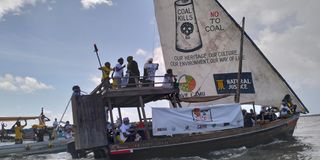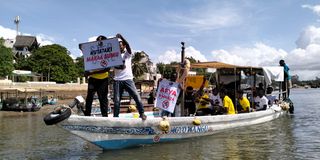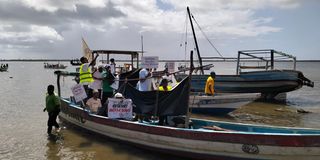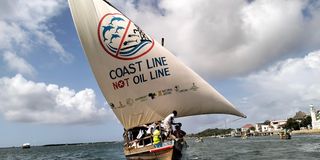
Lamu residents in boats and dhows in the Indian Ocean protest on June 5, 2025 to mark World Environment Day and oppose harmful projects in the county.
While mass demonstrations in Kenya are becoming increasingly controversial and tense, protesters in Lamu County have been quietly redefining what resistance can look like.
Public demonstrations in the region have taken on a unique form. Rather than barricading roads and burning tyres, Lamu residents often take their grievances into the Indian Ocean.
With placards in hand, they board boats and dhows, forming floating processions that sail through the waters, turning the sea into a stage on which to exercise their democratic rights to assemble and picket.

Lamu residents protest on June 5, 2025 to mark World Environment Day and oppose harmful projects in the county.
Demonstrators gather in central locations such as the seafront area of Lamu Old Town or the Mokowe mainland, before proceeding to marine vessels to take part in this dramatic yet peaceful form of protest. Once at sea, they form convoys of boats and dhows, singing and dancing to express solidarity over issues affecting their community.
Mr Mohamed Somo, a Lamu native and chairman of the Indian Ocean Water Body (IOWB) lobby group, explained that this phenomenon is rooted in geography, history and identity.
“In Lamu, we grew up seeing the ocean already surrounding us. So, we feel we’re part and parcel of the ocean. Our lives are ocean-dependent. We depend on the ocean for fishing, transport among other benefits. That’s why we always associate ourselves with the ocean because of its significant impact on us. We can’t do without it,” said Mr Somo.

Lamu residents in a boat in the Indian Ocean protest on June 5, 2025 to mark World Environment Day and oppose harmful projects in the county.
This connection runs deep in Lamu’s cultural fabric. Mr Salim Mzee, an elder at Lamu Island, sees the practice as both symbolic and strategic. He notes that ocean-based protests attract attention in a way that land protests may not.
“As coastal communities, we have no option but to involve the ocean in our day-to-day issues, including events such as protests. As you know, the ocean provides food, resources and livelihoods for us. So, using dhows and boats at sea during protests sincerely portrays how deeply the ocean is intertwined with our cultural identity and heritage,” said Mr Mzee.
Muturi Kamau, an environmental activist and the national coordinator of the Kenya Oil and Gas Working Group, said that Lamu’s geography plays a significant role in shaping this form of activism. He argues that the vastness and symbolic power of the sea make it an ideal setting for protest.
“Ocean protests, particularly in places like Lamu where the volume of maritime activity is high, will mean normal maritime activities or traffic are disrupted, hence, drawing attention to the protestors’ cause and making it difficult for authorities to ignore their grievances,” he said.

Lamu residents in boats and dhows in the Indian Ocean protest on June 5, 2025 to mark World Environment Day and oppose harmful projects in the county.
He adds that these protests are especially effective when the issues involve marine-based livelihoods or environmental concerns, as they highlight the close link between the ocean and the community’s way of life.
“For instance, if the protest is related to fishing rights, environmental issues, or the impact of development projects on coastal communities, using boats or dhows can directly demonstrate the connection between these issues and the protesters’ way of life,” said Mr Kamau.
Community elder Mbwana Shee echoes these sentiments, emphasising that the bond between the ocean and the coastal communities is inseparable.
“We can’t isolate the ocean whenever we’re faced with issues that we aren’t happy about. The sea in Lamu and the Coast plays a vital role in our daily life. We always stage protests in the Indian Ocean as a means to show how close we are to it and the zeal and determination we have in protecting it,” he said.
Environmental conservationist Mariam Haroun views ocean protests as a means of defending marine ecosystems and the livelihoods of those who depend on them against harmful development projects.

Lamu residents in boats and dhows in the Indian Ocean protest on June 5, 2025 to mark World Environment Day and oppose harmful projects in the county.
“Even before the government started plans to establish the Lamu Port in 2009, we had resorted to undertake demos inside the Indian Ocean as a way of protecting it. Since then, it has become a trend for us. We felt our ocean was under threat. This has helped to protect and preserve the ocean. People and even the government fear doing anything that poses a risk to our marine ecosystem,” she said.
In March 2021, fishermen in Lamu sailed out in their boats and dhows to protest escalating tensions between the Kenyan and Somali authorities regarding a dispute over the maritime boundary. The contested triangle, which covers over 100,000 square kilometres and is rich in marine life and crude oil reserves, is crucial to the survival of coastal communities on both sides.
More recently, on June 5 this year, Lamu residents and activists staged yet another protest in the Indian Ocean to raise awareness of the importance of protecting marine ecosystems from potentially destructive projects.








